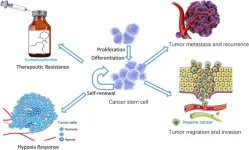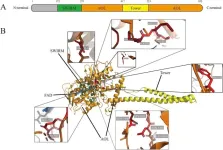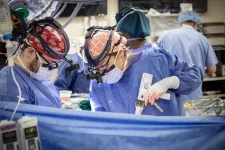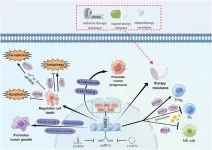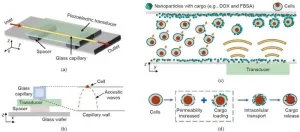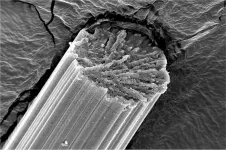(Press-News.org) A study published March 6 in The Lancet Regional Health — Americas highlights a growing divide in cardiovascular health in the U.S., showing that wealth and education play a significant role in heart disease risk.
The research, led by Salma Abdalla, MBBS, DrPH, an assistant professor of public health at Washington University in St. Louis, reveals that the top 20% of high-income, college-educated Americans have far lower rates of cardiovascular disease than the rest of the population — disparities that have widened over the past two decades.
Abdalla initiated the work while at Boston University’s School of Public Health before joining WashU’s newly established School of Public Health.
Cardiovascular disease (CVD) remains the leading cause of illness and death in the U.S., but this emerging research highlights diverging trends; the remaining 80% of the population continues to face higher risks, reflecting the nation’s growing income gap.
Despite the U.S. spending more on health care per person than any other high-income country, outcomes continue to lag behind, particularly for those with lower incomes and less education. Life expectancy for the richest 1% of Americans is now 10 years higher than for the poorest 1%. These outcomes have worsened compared with other high-income countries.
The study analyzed 20 years of data from nearly 50,000 adults who participated in the National Health and Nutrition Examination Survey between 1999 and 2018. Participants were grouped by income and education. Researchers examined the prevalence of four major cardiovascular conditions: congestive heart failure, angina, heart attack and stroke.
Statistical models showed that low-income non-college graduates had 6.34 times the odds of congestive heart failure, 2.11 times the odds of angina, 2.32 times the odds of a heart attack and 3.17 times the odds of a stroke, compared with their wealthier, college-educated peers.
Disparities persisted even after adjusting for demographics and health markers such as body mass index, blood pressure and cholesterol levels. High income and education consistently correlated with better heart health.
The findings suggest that income and education play a complex role in shaping heart health, with future studies needed to examine their interaction. The differences observed in the burden of CVD, even after accounting for certain biological and lifestyle factors, may be attributed to multiple, intersecting reasons. For example, a lack of economic security can contribute to chronic physiological stress. Higher-income and more educated patients may have cumulative structural access to health-promoting behaviors and activities throughout their lives. Additionally, they are likely to receive more thorough medical care with better continuity and earlier interventions. They may also demonstrate better medication adherence, experience lower environmental toxin exposure and benefit from stronger support systems.
“The accumulation of economic and educational advantages appears to drive better health outcomes, rather than any single factor alone,” Abdalla said. “Wealth and education cluster among a small, advantaged group, while the majority of Americans face an increased risk of heart disease.”
Addressing CVD, she said, requires more than expanding health-care access. It also demands policies that promote long-term broad access to economic opportunity and educational equity, breaking down structural barriers.
The study’s senior author, Sandro Galea, MD, DrPH, the Margaret C. Ryan Dean of the School of Public Health and the Eugene S. and Constance Kahn Distinguished Professor in Public Health at WashU, emphasized the policy implications of the findings.
“The continued widening of health disparities in the U.S. underscores the need for action,” Galea said. “If we want to improve public health outcomes, we must address the root causes — economic opportunity, education and access to resources that support long-term health.”
This research was funded by The Rockefeller Foundation and involved collaboration with the School of Social and Political Science at the University of Edinburgh and the New Balance Foundation Obesity Prevention Center at Boston Children’s Hospital.
END
Study reveals widening heart disease disparities in the US
Wealthy, educated Americans face far fewer health risks
2025-03-07
ELSE PRESS RELEASES FROM THIS DATE:
The role of ubiquitination in cancer stem cell regulation
2025-03-07
This review highlights the critical role of ubiquitination in governing the functionality of cancer stem cells (CSCs), shedding light on potential therapeutic targets for combating tumor progression, recurrence, and drug resistance. Published in Genes & Diseases, this article explores the intricate mechanisms through which the ubiquitin (Ub) system regulates key pathways essential for CSC maintenance and survival.
Ubiquitination, a fundamental post-translational modification, plays a pivotal role in protein stability, cellular signaling, and gene expression, particularly in the context of CSCs. Dysregulation ...
New insights into LSD1: a key regulator in disease pathogenesis
2025-03-07
A new review highlights the pivotal role of LSD1 (lysine-specific demethylase 1) in regulating critical cellular processes and its implications for human diseases. This article sheds light on how post-translational modifications (PTMs) influence LSD1 activity, impacting its function in gene regulation and disease progression.
LSD1 is a histone demethylase that plays a significant role in chromatin remodeling and gene expression by modifying histone H3 lysine residues. It interacts with various protein complexes, allowing it to serve as both a transcriptional activator and repressor. The intricate modifications ...
Vanderbilt lung transplant establishes new record
2025-03-07
Surgeons and teams with Vanderbilt Lung Transplant performed 99 lung transplants in 2024, the most ever in one year. Two of the procedures involved combined organ transplants.
For the second calendar year in a row, Vanderbilt Lung Transplant has the busiest program in the Southeast and leads the nation in innovation in organ preservation and regeneration.
The Vanderbilt Transplant Center is now home to the nation’s eighth largest lung transplant program by volume, and is among the best in long-term outcomes, demonstrating the ...
Revolutionizing cancer treatment: targeting EZH2 for a new era of precision medicine
2025-03-07
The critical role of EZH2, an essential epigenetic regulator, in cancer progression and treatment is underscored in this new review article published in Genes & Diseases. The study highlights the transformative potential of EZH2 inhibition, paving the way for a new generation of targeted therapies aimed at disrupting tumor growth and overcoming treatment resistance.
EZH2, a core component of the Polycomb Repressive Complex 2 (PRC2), plays a fundamental role in silencing tumor suppressor genes through histone methylation. Its overexpression has been ...
Metasurface technology offers a compact way to generate multiphoton entanglement
2025-03-07
Quantum information processing is a field that relies on the entanglement of multiple photons to process vast amounts of information. However, creating multiphoton entanglement is a challenging task. Traditional methods either use quantum nonlinear optical processes, which are inefficient for large numbers of photons, or linear beam-splitting and quantum interference, which require complex setups prone to issues like loss and crosstalk.
A team of researchers from Peking University, Southern University of Science and Technology, and the University of Science and Technology of China recently made ...
Effort seeks to increase cancer-gene testing in primary care
2025-03-07
Up to 10% of cancers are caused by genes that can be easily detected by commercially available tests. These include such common cancers as cancer of the breast, ovary, colon, stomach, uterus and pancreas.
“We don’t routinely screen for cancer susceptibility genes in primary-care settings because genetic testing is often considered too complicated and primary care doctors already have so many things they need to address,” noted lead author Dr. Elizabeth Swisher, a UW Medicine gynecological oncologist. "But it is an opportunity lost.”
In the JAMA Network Open study published ...
Acoustofluidics-based method facilitates intracellular nanoparticle delivery
2025-03-07
A recent study published in Engineering presents an innovative acoustofluidics-based approach for intracellular nanoparticle delivery. This method offers a new way to transport various functional nanomaterials into different cell types, potentially revolutionizing therapeutic applications and biophysical studies.
The efficient delivery of biomolecular cargos into cells is crucial for biomedical research, including gene therapies and drug delivery. However, traditional delivery methods such as endocytosis of nano-vectors, microinjection, and electroporation have limitations. They may require time-consuming processes, complex operations, or expensive equipment. ...
Sulfur bacteria team up to break down organic substances in the seabed
2025-03-07
Sulfate-reducing bacteria break down a large proportion of the organic carbon in oxygen-free zones of the Earth, and in the seabed in particular. Among these important microbes, the Desulfobacteraceae family of bacteria stands out because its members are able to break down a wide variety of compounds – including some that are poorly degradable – to their end product, carbon dioxide (CO2).
A team of researchers led by Dr Lars Wöhlbrand and Prof. Dr Ralf Rabus from the University of Oldenburg, Germany, has investigated the role ...
Stretching spider silk makes it stronger
2025-03-07
When spiders spin their webs, they use their hind legs to pull silk threads from their spinnerets. This pulling action doesn’t just help the spider release the silk, it’s also a crucial step in strengthening the silk fibers for a more durable web.
In a new study, Northwestern University researchers have discovered why the role of stretching is so important. By simulating spider silk in a computational model, the team discovered the stretching process aligns the protein chains within the fibers and increases the number of bonds between those ...
Earth's orbital rhythms link timing of giant eruptions and climate change
2025-03-07
On ten thousand to million years time scales, climate dynamics on the Earth’s surface are driven by both external and internal processes. Earth`s interior provides heat from radioactive decay and chemical compounds by volcanic degassing, such as sulfur dioxide (SO2) and carbon dioxide (CO2). Quasiperiodic changes in Earth’s orbit around the sun regulate the amount of incoming solar radiation on the planet’s surface as well as its distribution across latitudes, affecting the length and intensity ...
LAST 30 PRESS RELEASES:
Fame itself may be critical factor in shortening singers’ lives
Daily coffee drinking may slow biological ageing of people with major mental illness
New highly efficient material turns motion into power – without toxic lead
The DEVILS in the details: New research reveals how the cosmic landscape impacts the galaxy lifecycle
After nearly 100 years, scientists may have detected dark matter
Gender imbalance hinders equitable environmental governance, say UN scientists
Six University of Tennessee faculty among world’s most highly cited researchers
A type of immune cell could hold a key to preventing scar tissue buildup in wounds
Mountains as water towers: New research highlights warming differences between high and low elevations
University of Tennessee secures $1 million NSF grant to build semiconductor workforce pipeline
Biochar shows powerful potential to build cleaner and more sustainable cities worldwide
UT Health San Antonio leads $4 million study on glucagon hormone’s role in diabetes, obesity
65-year-old framework challenged by modern research
AI tool helps visually impaired users ‘feel’ where objects are in real time
Collaborating minds think alike, processing information in similar ways in a shared task
Routine first trimester ultrasounds lead to earlier detection of fetal anomalies
Royal recognition for university’s dementia work
It’s a bird, it’s a drone, it’s both: AI tech monitors turkey behavior
Bormioli Luigi renews LionGlass deal with Penn State after successful trial run
Are developers prepared to control super-intelligent AI?
A step toward practical photonic quantum neural networks
Study identifies target for disease hyper progression after immunotherapy in kidney cancer
Concordia researchers identify key marker linking coronary artery disease to cognitive decline
HER2-targeted therapy shows promising results in rare bile duct cancers
Metabolic roots of memory loss
Clinical outcomes and in-hospital mortality rate following heart valve replacements at a tertiary-care hospital
Too sick to socialize: How the brain and immune system promote staying in bed
Seal milk more refined than breast milk
Veterans with cardiometabolic conditions face significant risk of dying during extreme heat events
How plants search for nutrients
[Press-News.org] Study reveals widening heart disease disparities in the USWealthy, educated Americans face far fewer health risks
